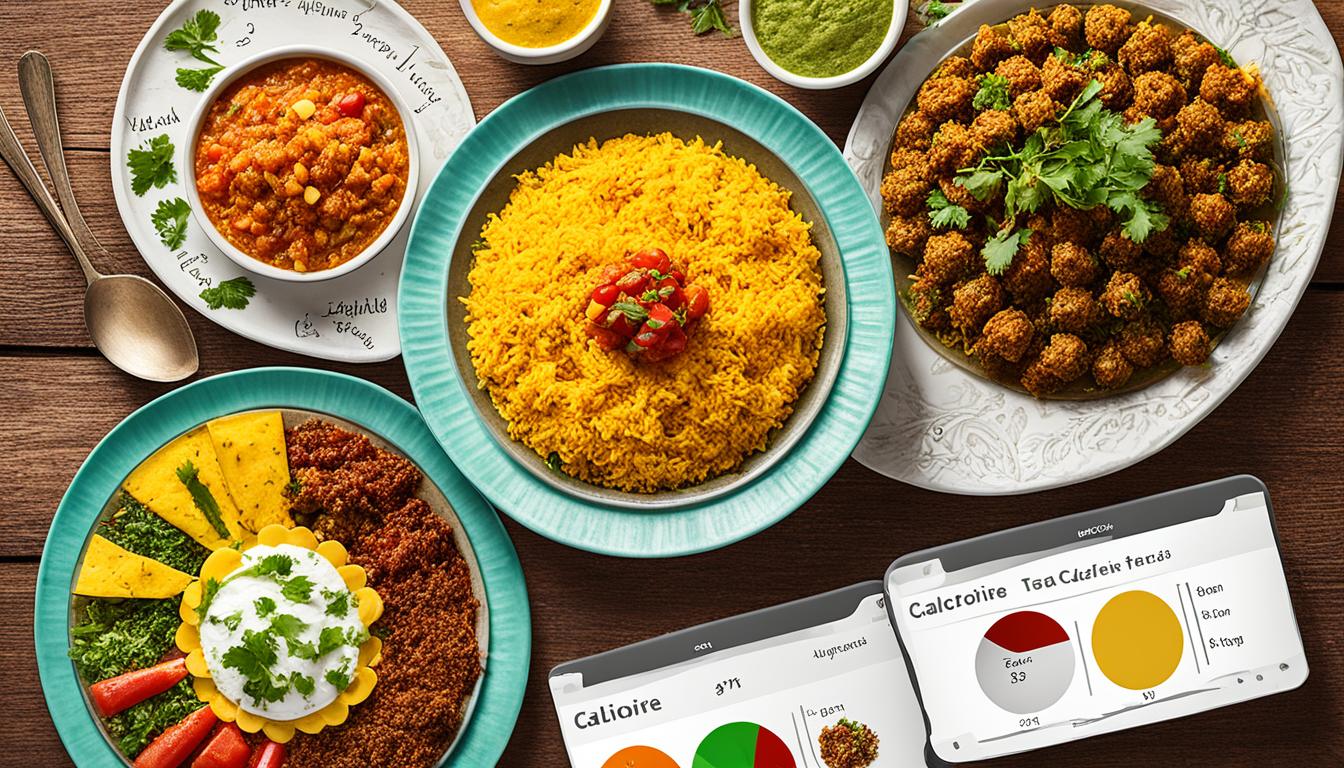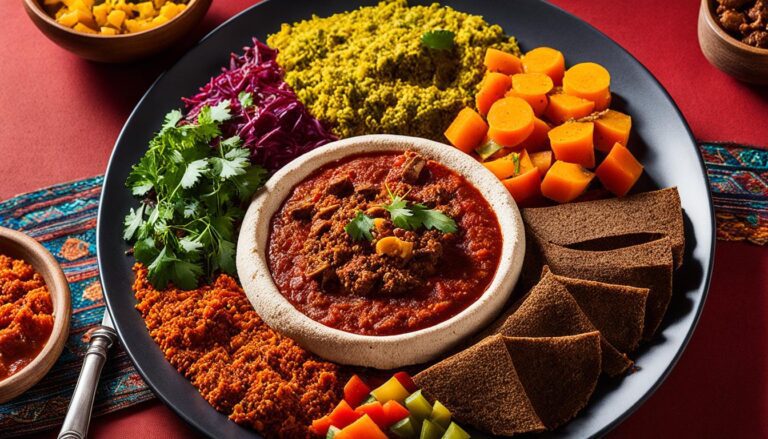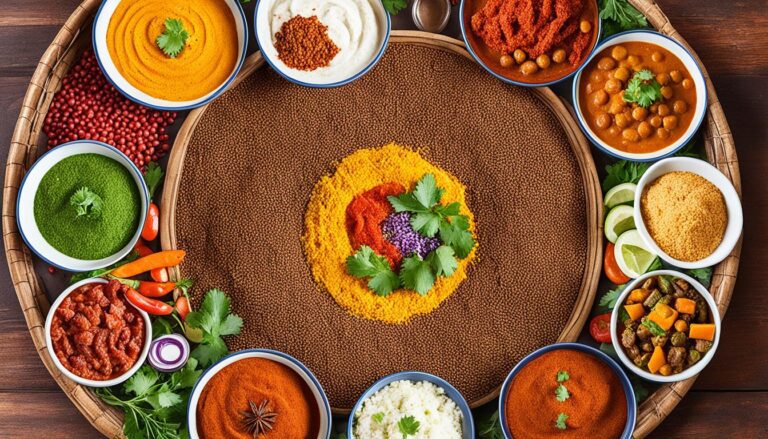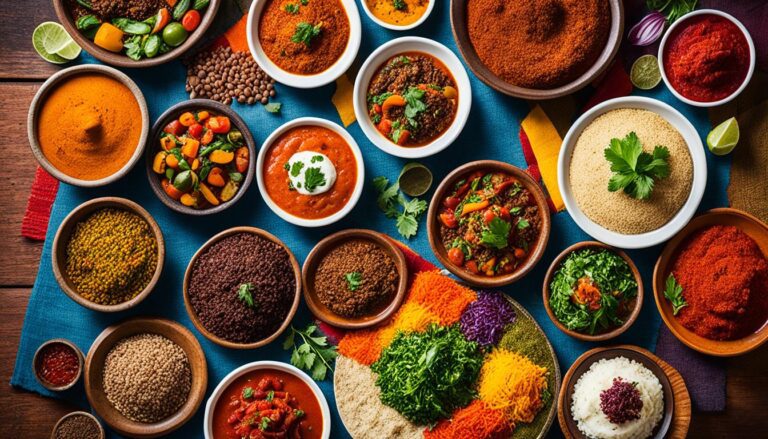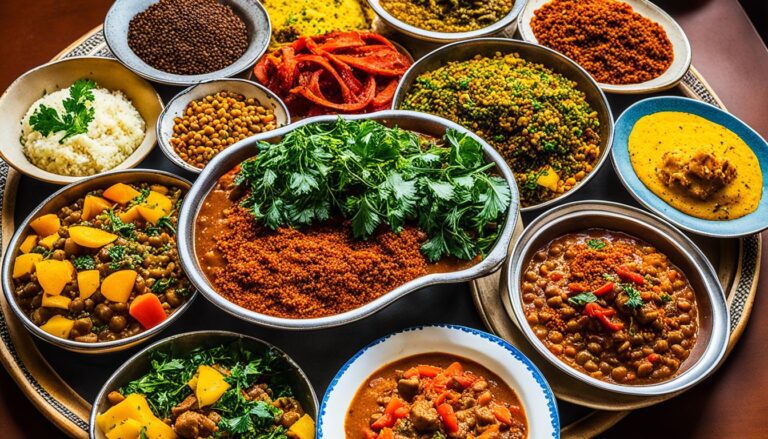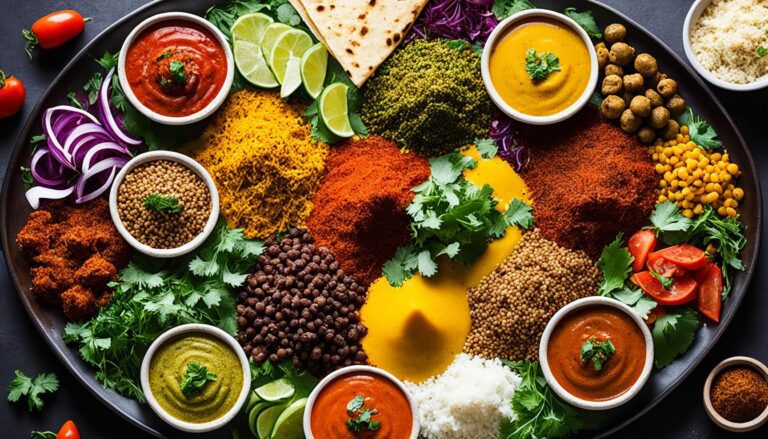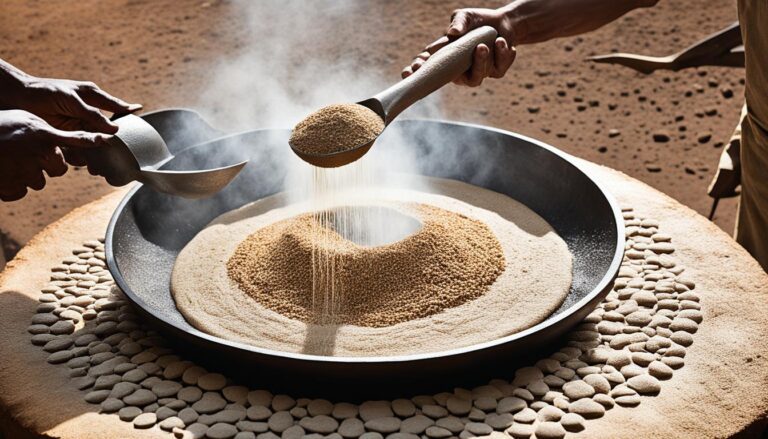How Many Calories Is in Ethiopian Food?
Have you ever wondered how many calories are in your favorite Ethiopian dishes? Ethiopian food is renowned for its rich flavors and aromatic spices, but what about its calorie content? Are these delectable dishes as calorie-dense as they taste, or do they offer a surprising twist?
In this article, we will delve into the calorie content of Ethiopian food and help you understand just how many calories you can expect in this delicious cuisine. We’ll explore the different factors that can affect the calorie count and provide tips on making calorie-conscious choices without compromising on flavor.
Key Takeaways:
- Explore the calorie content of popular Ethiopian dishes.
- Understand the factors that influence calorie counts in Ethiopian cuisine.
- Discover tips for making calorie-conscious choices when enjoying Ethiopian food.
- Enjoy the flavors of Ethiopian cuisine while maintaining a balanced diet.
Understanding Ethiopian Cuisine
Before we delve into the calorie content of Ethiopian food, let’s first take a closer look at the rich and diverse world of Ethiopian cuisine. It’s a culinary experience that will leave you craving for more!
Ethiopian cuisine is famous for its vibrant flavors, aromatic spices, and unique cooking techniques. Traditional Ethiopian dishes are a delightful blend of influences from various regions, including North Africa, the Middle East, and India.
One of the stars of Ethiopian cuisine is injera, a sourdough flatbread that serves as the foundation for many meals. It has a slightly tangy taste and a spongy texture, making it perfect for scooping up stews and sauces.
The use of spices is another defining characteristic of Ethiopian cuisine. Berbere, a fiery red spice blend made from dried chili peppers, garlic, ginger, and various fragrant herbs, adds a distinct heat and complexity to many dishes. Niter kibbeh, a spiced clarified butter, is also commonly used to enhance flavors.
When it comes to ingredients, Ethiopian dishes often feature a variety of lentils, legumes, vegetables, and aromatic herbs. Some popular ingredients include chickpeas, lentils, collard greens, and Ethiopian mustard. Meat lovers will also find a wide range of options, from tender beef and lamb to flavorful chicken and fish.
One unique aspect of Ethiopian cuisine is the communal dining experience. Injera is traditionally served on large platters, with various stews, vegetables, and meats placed on top. Sharing a meal with friends and family is a cherished tradition in Ethiopian culture.
In the next section, we will explore some popular Ethiopian dishes and provide an overview of the calorie ranges you can expect. Get ready to tantalize your taste buds!
Popular Ethiopian Dishes and Calorie Ranges
In this section, we will highlight some popular Ethiopian dishes and provide an overview of the calorie ranges you can expect. Ethiopian cuisine is known for its vibrant flavors and unique spices, making it a culinary delight that attracts food enthusiasts from all over the world.
One of the most beloved dishes in Ethiopian cuisine is injera. It is a sourdough flatbread with a slightly tangy flavor and a spongy texture that serves as the foundation for many meals. Injera is typically made from fermented teff flour, which adds a distinct taste to the dish.
Another favorite is doro wat, a spicy chicken stew that is rich in flavor. This dish combines tender chicken pieces with a blend of aromatic spices, including berbere, a traditional Ethiopian spice mixture. Doro wat is often served with injera, creating a delicious and satisfying meal.
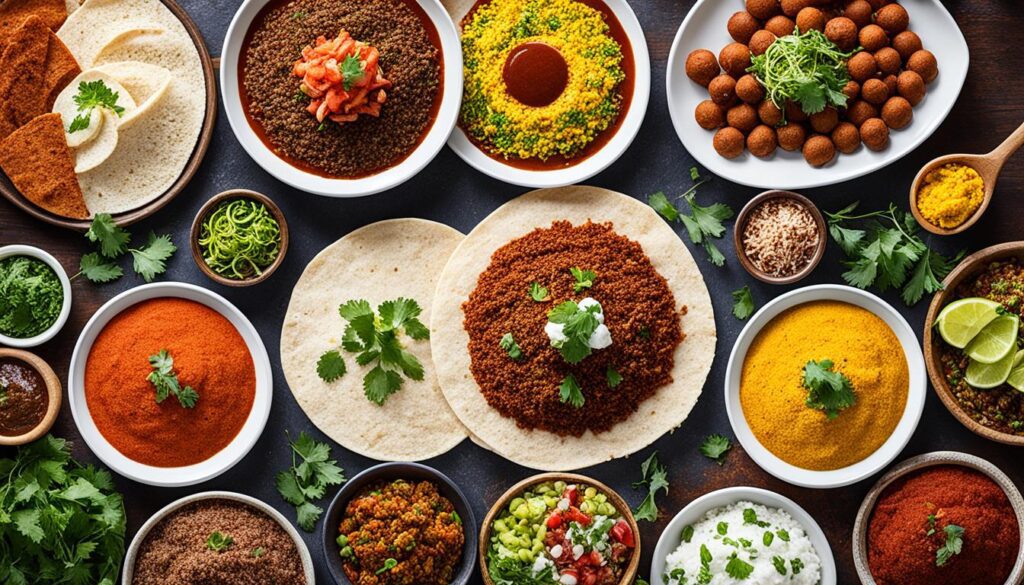
For those who enjoy beef, kitfo is a must-try dish. It is a minced raw or lightly cooked beef dish seasoned with spices and served with injera or bread. Kitfo is often accompanied by a variety of side dishes, such as fresh cheese and cooked vegetables, adding depth and variety to the meal.
Other popular Ethiopian dishes include tibs (grilled meat), shiro (a thick stew made from ground chickpeas or lentils), and ful medames (a hearty stew made from fava beans). Each dish offers a unique combination of flavors and textures, providing a delightful culinary experience.
When it comes to calorie ranges, Ethiopian dishes can vary depending on the ingredients used and the portion sizes. Injera, for example, is generally low in calories, making it a great option for those watching their calorie intake. Dishes like doro wat, kitfo, and tibs may have a slightly higher calorie content due to the protein and fat content.
Overall, Ethiopian cuisine offers a wide range of dishes that cater to different tastes and preferences. Whether you’re a fan of vegetarian dishes or prefer meat-based options, there is something for everyone in Ethiopian cuisine.
Factors Affecting Calorie Content in Ethiopian Food
Understanding the calorie content of Ethiopian food goes beyond simply knowing the type of dish. Several factors influence the calorie count, ranging from the ingredients used to the way the food is prepared and portion sizes. Let’s take a closer look at these factors:
Ingredients Used
The ingredients incorporated in Ethiopian cuisine play a significant role in determining its calorie content. From nutrient-rich legumes like lentils and chickpeas to lean meats and vegetables, the choice of ingredients can affect the overall calorie count. Opting for dishes with a higher proportion of vegetables and lean proteins can help keep the calorie content in check.
Cooking Methods
The cooking methods used in Ethiopian food preparation can also impact the calorie content. Traditional Ethiopian cooking often involves slow-cooking techniques, which rely on the natural flavors of the ingredients without excessive use of added fats or oils. On the other hand, certain dishes may involve frying or simmering in oil, increasing the calorie content. Being mindful of the cooking methods employed can assist in making calorie-conscious choices.
Portion Sizes
The serving sizes of Ethiopian dishes can vary, and larger portions naturally contribute to higher calorie intake. It’s important to be aware of portion sizes and practice mindful eating to avoid overconsumption. Consider sharing dishes with others or opting for smaller-sized portions to better manage your calorie intake.
By considering these factors, you can make informed choices when enjoying Ethiopian cuisine and ensure that you align your calorie intake with your dietary goals and preferences.
Making Calorie-Conscious Choices
If you are watching your calorie intake, we are here to help! Enjoying Ethiopian cuisine doesn’t mean you have to compromise on your dietary goals. By making calorie-conscious choices, you can still savor the flavors of this exquisite cuisine while maintaining a balanced diet.
One way to make calorie-conscious choices is by selecting dishes that are prepared with lean proteins, plenty of vegetables, and minimal added fats. Dishes like lentil stews, vegetable curries, and grilled chicken are excellent options for those seeking healthier alternatives.
Additionally, portion control plays a vital role in managing calorie intake. Ethiopian food is typically served communal-style on a large platter with injera, a traditional flatbread. To keep your portions in check, try using smaller plates or sharing dishes with your dining companions.
When it comes to injera, it’s important to note that this sourdough bread is a staple in Ethiopian cuisine. While it is delicious and pairs beautifully with various dishes, it does contribute to the calorie content. Consider enjoying smaller portions of injera or opting for whole-wheat varieties to reduce calorie intake.
Emphasizing the inclusion of fresh vegetables and legumes in your meal is another strategy to make calorie-conscious choices. These nutrient-dense options offer a satisfying and flavorful experience without excessive calories.
Stay Hydrated and Mindful
Remember to stay hydrated throughout your meal. Opt for water or unsweetened beverages to accompany your Ethiopian feast. Avoiding sugary drinks or alcoholic beverages can significantly reduce calorie consumption.
Lastly, be mindful of the condiments and sauces you choose. Some traditional Ethiopian sauces and dips, like berbere or shiro, may contain added oils or sugars. Consider using these condiments sparingly or exploring healthier alternatives like lemon juice, vinegar, or homemade spice blends.
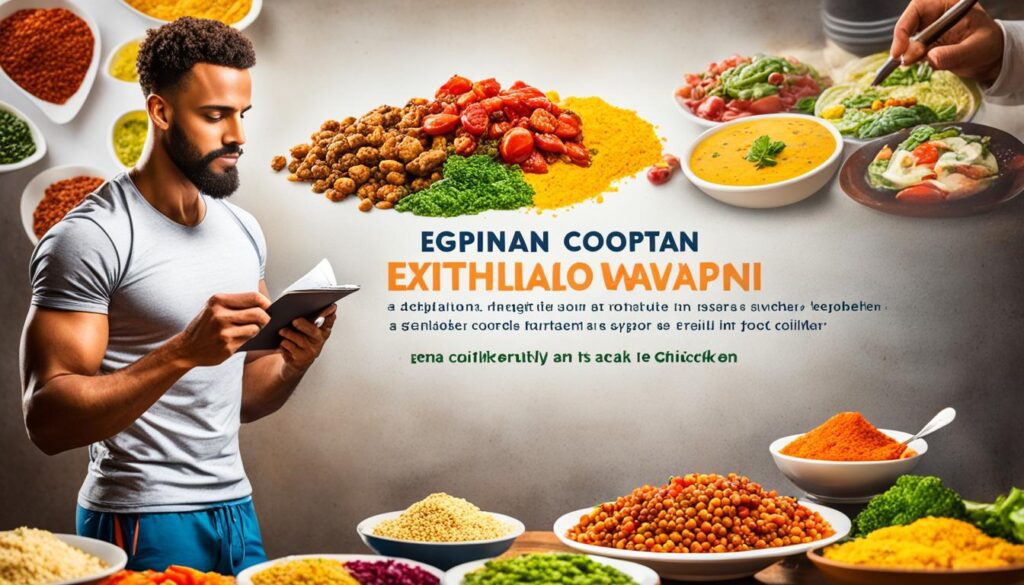
Enjoy Ethiopian Cuisine Without Guilt
With these tips and suggestions, you can confidently navigate the world of Ethiopian cuisine while making calorie-conscious choices. By incorporating lean proteins, fresh vegetables, and mindful portion control, you can indulge in the rich flavors of Ethiopian dishes without guilt. Let the vibrant colors, aromatic spices, and enticing aromas of Ethiopian cuisine enhance your culinary journey without compromising your dietary goals!
Conclusion
In conclusion, Ethiopian food offers a rich tapestry of flavors and culinary experiences. From the aromatic spices to the unique combination of ingredients, this cuisine captivates taste buds and satisfies the palate. But what about the calorie content?
By understanding the number of calories in Ethiopian dishes and making informed choices, you can enjoy the delectable offerings while staying mindful of your calorie intake. Whether you’re indulging in injera, savoring the traditional doro wat, or exploring the bold flavors of kitfo, it’s essential to keep moderation in mind.
Opting for smaller portions, choosing lean protein options, and incorporating vegetables into your meal can help create a balanced approach to enjoying Ethiopian cuisine without sacrificing taste. With these calorie-conscious choices, you can embark on a culinary journey through the delicious and diverse world of Ethiopian food with confidence.

